|
|
Cyllene

|
|
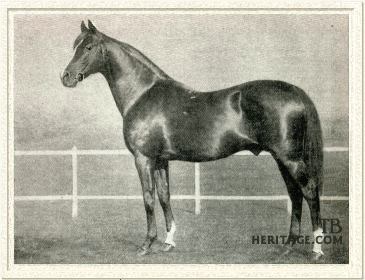 |
|
|
Cyllene was named for Mount Cyllene, located in the province of Arcadia in southern Greece, the birthplace of Hermes, herald of the Olympian gods. Perhaps this allegorical connection to Greek mythology was fitting for the chestnut son of Bona Vista and Arcadia, not only because of the play on his parents' names, but also because Cyllene was the immediate forerunner of a branch of the Bend Or sire line which is still the most influential tail-male thoroughbred line today.
A small, late foal whose two half-siblings had accomplished nothing of note on the track, not much was expected of Cyllene in his early days, but he defied expectations, becoming a top class racehorse. When he retired to stud, again, expectations were low, given the perceived weakness in his immediate family. Yet Cyllene again confounded his critics to become a two-time leading sire in England and later a leading sire in Argentina.
Bona Vista
As often happens with exceptional horses, the emergence of Cyllene as a horse of quality was unexpected. He was bred by Charles Day Rose at Hardwicke Stud near Pangebourne. His sire, Bona Vista, and his dam, Arcadia, were both owned by Rose, who later became a baronet. |
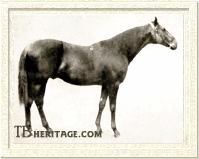
Bona Vista
| |
His sire, Bona Vista, had been a classic winner of the Two Thousand Guineas, and was an example of the popular Bend Or-Macaroni cross which also produced such good ones as Ormonde, Kendal, Martagon, and Orvieto. However, Bona Vista got little else in England besides Cyllene. He had been purchased by Rose as a yearling. He was later sold to Prince Louis Esterhazy to stand stud in Hungary, where he did exceptionally well, leading the sire list there in 1902-1905 and again in 1908. He left two daughters from his days in England: Vahren, destined to become the dam of The Tetrarch and Rose Tree, imported to America where she became the dam of American champion Roamer.
|
The female line of Cyllene was not a bad one, tracing to Maid of Masham. But it had not produced anything of exceptional merit for several generations, and it would be several more years before the advent of Star Shoot and Fair Play, successful racehorses who would join their maternal kinsman Cyllene as influential sires.
Second dam of Cyllene was Distant Shore (1880), a chestnut filly by Hermit, who was one of the first acquisitions made by Rose. He purchased her for 580 guineas at the annual Hampton Court yearling sale. As a racer she was useless, winning only a tiny race worth £100. But being a daughter of Hermit was enough to warrant keeping her for a broodmare; one foal, Gulliver, won the Hardwicke Stakes at Ascot, and another, Van Dieman's Land, ran third in Ayrshire's Derby. A mating with Isonomy yielded Arcadia, a filly who won twice as a juvenile -- a plate at Manchester worth £411, and the Royal Plate at Windsor, worth £1,125; at age three she ran unplaced in both the One Thousand Guineas and Coronation Stakes. Arcadia had two foals prior to Cyllene, a filly by Minting who ran unsuccessfully twice at age two and was sold, and a colt, Arcady, by Sheen, who failed to win in four races at age two, and after being sold won two selling plates at age three before disappearing from recorded racing history.
Cyllene was Arcadia's first foal by Bona Vista, and he was born May 28, 1895. He was a small colt, and since Rose did not see much merit in the dams previous produce, he decided it was not worthwhile to nominate her most recent to the classics. When Cyllene grew into a very handsome yearling and began to display talent on the gallops, Rose began to realize his mistake, but it was too late. The colt had to prove his mettle without the benefit of classic exposure.
Cyllene on the Turf
As a two-year-old, Cyllene emerged as one of the most highly-regarded youngsters of the season. His debut came at Liverpool on March 26, 1897, in the Sefton Park Plate. The other runners were an undistinguished lot, but even so, Cyllene ran masterfully and won by three lengths. His performance was all the more impressive given the fact that he was still two months and two days shy of his real second birthday. His next start came in the Worth Stakes at Gatwick, weighted with 129 pounds. Cyllene won by three-quarters of a length from a smart filly by Symington who was as yet unnamed, though later won stakes under the name Wylam.
Cyllene appeared next at Ascot where he easily carried 129 pounds to victory over Nun Nicer, a dual stakes winner who was carrying three pounds less. This set Cyllene up nicely for the rich National Breeders Produce Stakes at Sandown Park. Under 130 pounds, Cyllene successfully battled Ebba, carrying seven pounds less, to win by a head. Rested until October, Cyllene reappeared in the valuable Imperial Produce Stakes at Kempton Park. His unbeaten record earned him an impost of 136 pounds, a staggering weight for a juvenile. He gave it a good try, but went under by less than a length to Dieudonne, an Amphion colt carrying ten pounds less. That colt went on to capture the Middle Park Plate while Cyllene was retired to winter quarters. He had won four of five starts and had carried 129 pounds or more to victory on three of those occasions, an impressive feat for a colt who had been held in such low esteem less than a year earlier. |
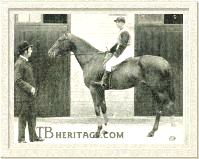
Cyllene in Racing Trim
| |
Cyllene made only four starts at the age of three, his opportunities limited by his lack of classic engagements. He started out in April with a disappointing third place finish to an unheralded and unnamed daughter of Sejanus in the Column Produce Stakes. He next appeared in the Newmarket Stakes, run two weeks after the Two Thousand Guineas. Cyllene had no trouble winning from an Ayrshire colt, Heir Male, with a son of Janissary named Jeddah well beaten. Since the latter colt came back to win the Derby at odds of 100-1 and Heir Male was unplaced in the Derby, the form of the Newmarket Stakes put Cyllene at the top of the three-year-old class.
|
That opinion was confirmed by his performance in his next start, the Jockey Club Stakes, run over 1-1/4 miles at Newmarket at the end of September. In the Jockey Club Stakes Cyllene took the track against a stellar field: Chelandry, One Thousand Guineas winner and Oaks runner-up the previous season; Velasquez, another four-year-old who had finished second the previous spring to Galtee More in both the Two Thousand Guineas and the Derby and second to Persimmon in the Eclipse Stakes, in addition to winning the Princess of Wales Stakes and the Champion Stakes; Airs and Graces, an Ayrshire filly which had captured the Oaks in the spring; and multiple stakes winner Dieudonne. It was a brilliant performance for Cyllene to win by four lengths with Velasquez second and Chelandry third, with Dieudonne and Airs and Graces unplaced.
Cyllene closed out his three-year-old season with an easy win in the Sandown Park Foal Stakes, toting 140 pounds to a four length victory. The colt was then rested until the following spring. The Ascot Gold Cup, for which he was eligible, was his primary objective. A win in that prestigious race would cement his status as a horse of the highest class.
Cyllene was tuned up for the Gold Cup in the Triennial Stakes at Ascot, held two days before the Gold Cup, which he won easily. In the big race, he met a fine French horse, Gardefeu, a triple stakes winner in France that season. Cyllene put on the finest performance of his career, as he won the 2-1/2 mile event by eight lengths, with Gardefeu third.
All told, Cyllene had won nine of eleven starts and was second and third in the two races he lost. He had beaten classic winners and performers with consummate ease. He was often criticized that he defeated indifferent competition, but horses such as Chelandry, Airs and Graces, Velasquez, and even Jeddah, who reaffirmed his Derby form by winning the Prince of Wales Stakes after his Epsom triumph, were hardly indifferent performers. He won from five furlongs to 2-1/2 miles and carried up to 140 pounds successfully.
Cyllene in the Stud
With all his accomplishments as a racehorse, when he went to stud at his owner's farm in 1900, Cyllene was not well received. His fee was 150 guineas to start with, but it was reduced in 1905 to 100 guineas. Perhaps it was his lack of classic credentials, a prejudice that his female family had yet to produce a top class sire, or the fact that his sire had wound up in Hungary and had to that point, not distinguished himself with any other progeny except Cyllene. Cyllene's first crop of yearlings brought low prices at public auction. It was not until after 1905 that any of his yearlings sold for over 1000 guineas; this was after his 1902 crop, which included Cicero and Polymelus and six other winners, had won twenty-six races worth £15,532 in 1904, and after Cicero, at age three, had won the Derby.
Cyllene sired four winners of the Epsom Derby: Cicero, Minoru, Lemberg, and the filly Tagalie. This made him the first stallion in over 100 years, since Waxy in the early years of the nineteenth century, to sire four winners of the Epsom classic.
Cicero
CICERO, the first of this quartet, was bred by the fifth Earl of Rosebery and foaled in 1902, making him a member of Cyllene's second crop. Cicero's dam was the beautifully bred Gas, a daughter of Two Thousand Guineas and Derby winner Ayrshire out of the fine producer Illuminata. Gas had some talent as a runner, having placed third in the One Thousand Guineas. Cicero, her colt by Cyllene, was a handsome chestnut. Trained by Percy Peck at Exning near Newmarket, Cicero was unbeaten as a two-year-old, winning five races, including the Coventry Stakes at Ascot.
|
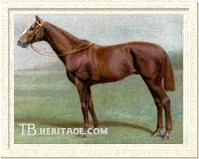
Cicero
| |
Withheld from the Two Thousand Guineas, Cicero made his three-year-old debut in the Newmarket Stakes and won easily. The Derby was an easier victory than his margin of three-quarters of a length suggested. After Tattenham Corner, Cicero and French invader Jardy, a royally bred colt by Flying Fox out of Oaks heroine Airs and Graces, were joined by Signorino. Those three waged a battle to the finish, with Cicero, under Danny Maher, prevailing in 2 minutes 39 seconds, a new record. Cicero raced only once more that season, finishing second to Val d'Or, a stablemate of Jardy. |
At four, Cicero won the Biennial Stakes at Newmarket, but made no show in the Ascot Gold Cup, won by Bachelor's Button, with the great filly Pretty Polly second. This was Cicero's last race. Retired to his owner's stud, The Durdans, near Epsom, he was fairly successful, his best offspring including: Prue, winner of the National Breeders Produce Stakes, Coronation Stakes and third in the One Thousand Guineas; Friar Marcus, winner of several races, including the Prince of Wales Stakes, Rous Memorial Stakes, and Middle Park Plate; Kwang-su, out of Galicia by Galopin, won the Select Stakes at Newmarket and was second in both the Two Thousand Guineas and the Derby. Cicero died in 1923 at the age of 21 from ruptured intestines.
Minoru
MINORU was a bay colt of 1906 out of Mother Siegel, by the Hermit son Friar's Balsam. He was inbred three times to Hermit: his fourth dam was a full sister to Hermit, and Cyllene's second dam, as previously mentioned, was by Hermit. Minoru was bred in Ireland at Tully Stud by Col. William Hall Walker, later Lord Wavertree. Leased with five other colts to run in the colors of King Edward VII, Minoru at first showed very little ability and he was not really considered good enough to run in the classics. A fine run in the Greenham Stakes at Newbury altered the opinion of his trainer Richard Marsh somewhat, and it was decided to let him have his chance in the Two Thousand Guineas. The classic races were considered to be at the mercy of Alfred Cox's brilliant Bay Ronald colt, Bayardo, the unbeaten winner of all his seven starts as a juvenile. However, after a bitterly cold winter, many horses had their training regimens compromised, and Bayardo was a short horse when he went to the post for the Guineas. Minoru was just beginning to thrive, and he won in splendid fashion with Bayardo a lackluster fourth. Having gained a popular classic victory for the monarch, Minoru arrived at Epsom preferred in the betting to Bayardo, but both colts losing favoritism to the American colt, Sir Martin. |
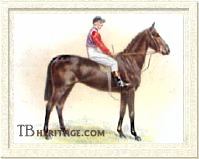
Minoru sired the influential broodmare Serenissima.
| |
During the running of the race, Sir Martin was slammed against the rails and fell. Luckily, he escaped serious injury, but the accident impeded several runners, including Bayardo. However, Minoru was in a handy position in front of the fracas, and gamely fought to the finish to win by a head from Louvois. Minoru went on to capture the St. James Palace Stakes at Ascot, the Sussex Stakes at Goodwood, and a minor stakes at Newmarket. Minoru ran unplaced in his only start at four, the City and Suburban Handicap, before the King's death in the spring of 1910 ended the lease agreement. |
Sent to stud at his birthplace in Ireland, Minoru served only a few seasons before he was sold to go to stud in Russia in 1913, where he was later joined by fellow Derby champion Aboyeur. Both he and Aboyeur disappeared during the Revolution. There was a fanciful tale that Minoru and Aboyeur survived, the two stallions harnessed to a cart and driven from Moscow to Novorossiysk, and then evacuated with the British Military Mission to Serbia, where they lived in peaceful anonymity until the end of their days.
Minoru left one notable offspring, his daughter Serenissima. Out of the fine mare Gondolette, Serenissima was only a minor winner, but she bred Ascot Gold Cup winner and St. Leger runner-up Bosworth to the cover of Son-in-Law; One Thousand Guineas and St. Leger winner Tranquil, by Swynford; and to the cover of Chaucer, the elegant filly Selene, winner of the Park Hill Stakes and dam of Derby champion and leading sire Hyperion, as well as major sires Sickle, Pharamond, Hunters Moon, and All Moonshine. Serenissima ensured that Minoru, despite his mysterious end, did not have his name disappear from future generations.
Lemberg
The third Derby champion sired by Cyllene was LEMBERG (1907). Bred by Alfred Cox, Lemberg was out of the Galopin mare Galicia, the dam of champion Bayardo and the classics-placed Kwang-su. Lemberg was a talented horse, often overshadowed by his more brilliant half brother Bayardo. Yet the list of his victories and placings is at least as impressive. He placed in the two classics he lost, whereas Bayardo finished unplaced in both the Guineas and the Derby. As a two-year-old, Lemberg captured six races, including the Middle Park Plate and the Dewhurst Stakes. At three, in addition to the Derby, he captured the St., James Palace Stakes, Jockey Club Stakes, Champion Stakes, Lowther Stakes, and dead-heated with Neil Gow in the Eclipse Stakes. He also finished second in the Two Thousand Guineas and third to Swynford in the St. Leger. |
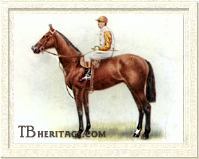
Lemberg was a top two-year-old and at age 4 could stay the Doncaster Cup distance.
| |
At four, Lemberg beat Swynford in the Coronation Cup, ran second to him in the Princess of Wales Stakes, and then went on to win the Doncaster Cup, the Champion Stakes and the Lowther Stakes. Retired to Hamilton Stud, Newmarket, Lemberg was leading British sire in 1922, and sired Pogrom, winner of the Oaks and Coronation Stakes; Ellangowan, winner of the Two Thousand Guineas, St. James Palace Stakes and Champion Stakes; and Taj Mah, winner of the One Thousand Guineas. He also sired classics-placed Lemonora and the dams of Derby winner Felstead and Mon Talisman, winner of the Prix du Jockey Club and Prix de l'Arc de Triomphe. Lemberg died at the age of 21 in 1928. |
Tagalie
TAGALIE, Cyllene's final British classic champion, was a lovely grey filly of 1909 out of the French-bred mare Tagale, by Le Sancy. Bred and owned by British financier Walter Raphael, she was trained by Dawson Waugh at Somerville Lodge near Newmarket. As a juvenile, Tagalie won the Post Stakes and finished third in the Cheveley Park Stakes. |
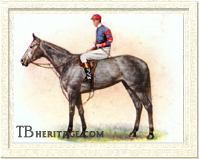
Cyllene's daughter Tagalie beat the colts by four lengths in the Derby of 1912.
| |
She was not seen under colors again until the following spring in the One Thousand Guineas, when at odds of 20-1, she defeated Belleisle, her conqueror in the Cheveley Park Stakes. Tagalie then finished a good second to another Cyllene offspring, Cylgad, in the Newmarket Stakes. In the Derby, her next start, Tagalie, ridden by Johnny Reiff, the jockey who had guided Orby to his Derby victory five years before, went right to the lead and won by an effortless four lengths from Jaeger, with a highly-regarded Rock Sand colt named Tracery, making his racing debut, in third place. This was Tagalie's finest hour, as she finished unplaced in each of her three remaining races: the Oaks, the Eclipse Stakes, and the St. Leger. |
Tagalie was a disappointment in the stud. She produced only four foals. Her best was the Bayardo colt Allenby, winner of the Newmarket Stakes and second to Tetratema in the Two Thousand Guineas. Her family vanished from the British racing scene, but through her daughter Mabella, by Sunstar, have descended the likes of American two-year-old filly champion Rose Jet and Argentinian two-year-old champion Tierno. Tagalie died soon after foaling in 1920, at the age of eleven.
Cyllene had other good winners, among them BRIDGE OF EARN, winner of the Newbury Autumn Cup; LYCAON (1908), winner of the Chester Vase; CELLINI (1908), winner of the National Breeders Produce Stakes; SILENT LADY (1905), winner of the Great Northern Leger and the Great Foal Stakes and second in both the Park Hill Stakes and Yorkshire Oaks; TRONADOR (1911), winner in Italy of the Gran Premio di Milano; MAID OF THE MIST (1906), out of the great racemare Sceptre, captured the Cheveley Park Stakes; MAID OF CORINTH (1907), a full sister to Maid of the Mist, ran a strong second in the One Thousand Guineas; BELLAVISTA (1904), a winner of the Rous Memorial Stakes and the Windsor Castle Stakes; CASTELLINE (1908), who won the Great Surey Foal Stakes and several other races; CORRIE RAE (1905), a winner of five of her 24 starts, including the Pontrefact Handicap and the Pontrefact Welter Handicap; Helicon (1908), who won the Hastings Plate; CYLGAD (1909), a good two-year old who won the Breeders' Foal Plate and the Newmarket Stakes. A Cyllene son, CAPTIVATION, only ran once, unsuccessfully, but was a successful sire who got the good Kircubbin and Casquetts, second dam of Pharis II.
Polymelus
But Cyllene's most important offspring was Polymelus. Bred by the Earl of Crewe, the son-in-law of the Earl of Rosebery, Polymelus was from the same 1902 foal crop as Cicero. |
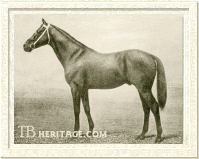
Bridge of Earn became a prominent sire in Great Britain.
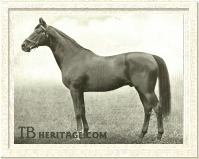
Polymelus was champion sire in England five times, and got Phalaris.
| |
His pedigree was impeccable: he was out of the Hampton mare Maid Marian, a half-sister to Memoir, winner of the Oaks and St. Leger and to La Fleche, winner of the One Thousand Guineas, Oaks, St. Leger, and Ascot Gold Cup. Maid Marian herself could not win, but as a broodmare she did well. In addition to Polymelus, she was the dam of the Galopin horse Grafton, who was unraced, but became a leading sire in Australia, and of Ercildoune, by Kendal, a winner of the Duke of York Stakes.
Polymelus was given an ardous racing campaign. He won 11 of 31 races, and captured some prestigious events, including the Rous Memorial Stakes and Richmond Stakes at two, the Gatwick Stakes and Duke of York Stakes and Durham Produce Plate at three, and the Cambridgeshire Handicap, Duke of York Stakes, Princess of Wales Stakes, and Champion Stakes at four. He finished fifth to Cicero, Llangibby, and Signorino in the Newmarket Stakes, second to Oaks heroine Cherry Lass in the St. James Palace Stakes, second to Challacombe in the St. Leger, and second to St. Amant in the Jockey Club Stakes.
His record was one of a very good horse, just a notch below the very best runners of his day. |
Sold twice during his racing career, he retired as the property of Solomon (Solly) Barnato Joel, and was sent to serve mares at Joel's Maiden Erlegh Stud. There, Polymelus swiftly assumed the mantle of his sire Cyllene as the best stallion in England. Polymelus was champion sire five times, and sired five classic winners. The classic winners by Polymelus were: Black Jester (St. Leger), Cinna (One Thousand Guineas), Fifinella ( Derby Stakes and Oaks, second in the One Thousand Guineas), Pommern (Two Thousand Guineas, Derby, and St. Leger), and Humorist (Derby and third in the Two Thousand Guineas). Polymelus also sired classics-placed Maiden Erlegh, Dominion, Craigangower, Parth, and Polyphontes, Corcyra, Glaciale, and Silvern, a full sister to Fifinella. His most important son, however, was speedy Phalaris (1913, out of Bromus by Sainfoin), the most influential sire of the twentieth century.
Cyllene in Argentina
It was a stroke of good fortune that Cyllene sired such a son as Polymelus, for Cyllene, despite his tremendous success, surprisingly did not remain in England. In 1905, Sir William Bass bought Cyllene for 30,000 guineas, and installed him at Richard Marsh's Egerton House Stud near Newmarket, where Cyllene stood alongside the likes of Ayrshire, Common, and St. Serf. However, he stood at Egerton House for only two years. He arrived there for the beginning of the 1906 breeding season, and was then sold in January, 1908 to the famed Ojo de Agua Stud in Argentina, departing Britain on July 24, 1908, never to return. That British breeders made a drastic mistake in letting him go to Argentina was illustrated when Minoru and Tagalie each won the Derby after his departure and he was named leading sire in Britain in 1909 and 1910. Cyllene went on to become just as successful in his new homeland, becoming leading sire in Argentina in 1913.
In Argentina, Cyllene sired four more classic winners: ENERGICA (1910), winner of the Gran Premio Carlos Pelligrini (Argentine St. Leger); SAINT EMILION (1913), winner of the Gran Premio Nacionale (Argentine Derby); GAULOIS, also a winner of the Gran Premio Nacionale; and PULGARIN (1918), a winner of the Gran Premio Nacionale and the Polla de Potrillos (Argentine Two Thousand Guineas). These winners made Cyllene the sire of a total of eight classic winners in two countries.
Cyllene as a Broodmare Sire
Though Cyllene was never a leading broodmare sire in either Great Britain or Argentina, he nevertheless sired some daughters who were top class producers. In England, his daughters produced a Derby winner and three that placed second in that race; an Oaks winner, and three Cesarewitch winners. In Argentina he was twice second in the list of leading sires of broodmares. In Great Britain, his most important daughters were:
BELLAVISTA (1904), out of the Nunthorpe mare Emotion, was a winner of the Windsor Castle Stakes. As a broodmare she produced Captain Cuttle to the cover of Hurry On. Captain Cuttle was a big, top-heavy colt, built much like his sire. With such a massive frame, Captain Cuttle had trouble with his forelegs throughout his career. Captain Cuttle captured the Derby Stakes and St. James Palace Stakes at three, but leg trouble curtailed his season. At four, he won the Prince of Wales Stakes at Kempton Park before his bad legs forced his retirement. Retired to his breeders stud, Lavington Park, he sired the One Thousand Guineas winner and Oaks runner-up Scuttle from the Tracery mare Stained Glass. Exported to Italy to stand at Mirafiori Stud near Turin, Captain Cuttle sired Pilade, a winner of the Derby Italiano, Gran Premio del Jockey Club, and Gran Premio dItalia. Captain Cuttle died at the age of thirteen after an accident while out at exercise in the spring of 1932. |
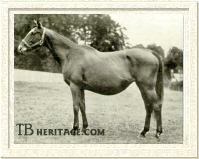
Daughter Maid of the Mist was dam of two classic winners.
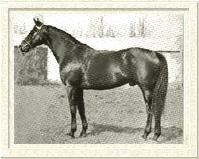
Multiple classic winner in Argentina, Ix, by Congreve, was out of Cyllene's daughter Betha. Photo courtesy Victoria Duggan.
| |
MAID OF THE MIST (1906), out of the legendary racemare Sceptre, was undoubtedly Cyllene's most influential daughter. A winner of the Cheveley Park Stakes, she never really lived up to her pedigree on the racetrack, but she was a successful broodmare.
Acquired by Major (later Viscount) Waldorf Astor, she foaled two classic winners. To the cover of Derby champion Sunstar, she produced Sunny Jane, a winner of the Oaks and second in the One Thousand Guineas, and Craig an Eran, victor in the Two Thousand Guineas, Eclipse Stakes, and St. James Palace Stakes, and runner-up by a neck to the ill-fated Humorist in the Derby Stakes.
Maid of the Mist's daughter Jura, by Gainsborough, became second dam of Ascot Gold Cup champion Tiberius.
Another daughter, Hamoaze (by Torpoint), won the Leicestershire Stakes and placed third in the Park Hill Stakes. She produced dual Eclipse Stakes winner Buchan, (by Sunstar) who also captured the Princess of Wales Stakes, Chester Vase, Doncaster Cup, and the Champion Stakes. His full brother, Saltash, also won the Eclipse Stakes. |
To the cover of Tracery, Hamoaze produced the colt Tamar, winner of the Gordon Stakes at Goodwood and second in the Derby to Captain Cuttle. Exported to Hungary in 1924, he became a leading sire in Austria. Hamoaze also produced St. Germans, by Swynford, a winner of the Coronation Cup and second in the Derby to Sansovino. Exported to the United States, he became North Americas leading sire in 1931, largely due to the exploits of his son, Twenty Grand, hero of the Kentucky Derby and Belmont Stakes.
MISTRELLA (1907), out of the Royal Hampton mare Ark Royal, was a winner of two small races, the Brandling Handicap and the Fitzwilliam Stakes. At stud, she was mated with the stallion Galloper Light, a son of Sunstar, and the produce was the filly Beam, winner of the Oaks Stakes in 1927.
AGACELLA (1909), a daughter of the St. Hiliare mare Merry Agnes, was a winner of the Criterion Nursery Handicap and produced the Swynford filly Donna Branca, a winner of the Coronation Stakes.
SHE was a filly out of the St. Simon mare Witty. Her major winner was sired by Santoi. Named He, the colt was victorious in the Coronation Cup.
BELLE VUE was a daughter of the Ayrshire mare Ayrshire Beauty. She gave Cyllene broodmare sire credit for a French classic winner when her daughter Doniazade, by Sardanapale, emerged victorious in the Prix de Diane, the French Oaks.
As a broodmare sire in Argentina, Cyllene was best represented by IX. A member of the first crop of Congreve, who would become Argentina's most prominent stallion, leading the Argentine sire list seven times, Ix captured the Gran Premio Carlos Pellegrini, the Gran Premio Nacionale, and the Gran Premio Jockey Club. Ix was produced from Cyllene's daughter Betha.
In the warm sunny climate of Argentina, amidst the lush splendor of Ojo de Agua, Cyllene lived a long, fruitful life. His final days were recounted by David R. Gunn in The Bloodstock Breeders' Review:
"I saw Cyllene, one of the grandest sires the world has ever seen, and the Grand Old Man of his kind, not on parade, but in his box, alive and yet dead. From his grand head to his shoulders, he was unchanged from his best days, but he was little more than a pathetic ruin behind. His back has fallen into a most pronounced dip, and there was little flesh covering his skeleton. While in his box he is docile, but he has lately begun to display temper during exercise (at the age of 28)! 'Take your last look at him,' said Tom Murphy (the stud manager), sadly enough, 'you'll never see him again."
Cyllene lived for two more years, passing away in the first part of 1925 at the ripe old age of thirty. During the last year of his life, the The Bloodstock Breeders' Review reported, "he lay on the floor of his box all the time," a hard end for such a courageous horse. He outlived his best sire son, Polymelus, by one year. Cyllene was buried in the Ojo de Agua cemetery, where the remains of the great stallion Congreve were later interred.
--Elizabeth Martiniak |
|
|
|

